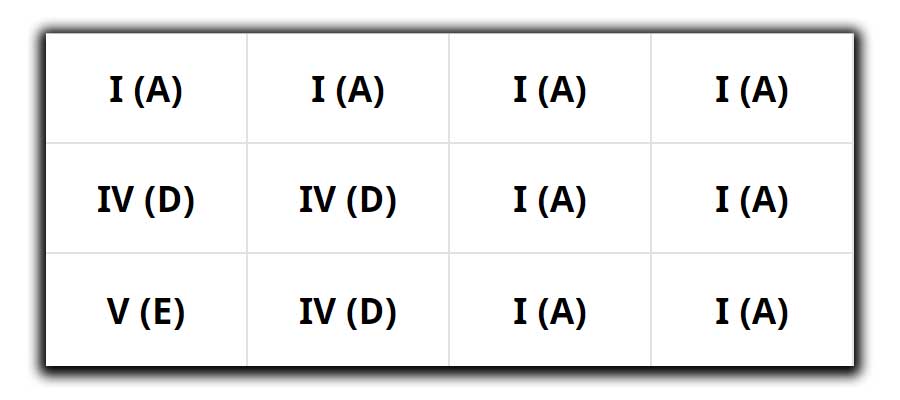12 Bar Blues Chords Progression
Learn How To Play An Easy Guitar Blues Song in the key of A
The video above shows you an easy 12 bar blues in the key of A.
For a better sound, use the palm of your right hand to gently mute the strings.
The chords for this songs are A, D and E. Download the Guitar Tabs.
The 12 Bars Song Structure
This lesson will introduce you to 12-Bar Blues , one of the most common song structure.
12-Bar Blues is not really a type of Blues, but a format , or template. By now you should know what a ‘Bar’ is, and 12-Bar Blues is exactly what it sounds like:12 bars of music, divided into 3 sections of 4 bars each.
It is structured much like some poetry, with a set number of syllables in a set number of lines. By now, you should also have a good working knowledge of chord progressions , so when we say that 12-Bar Blues is built around the chords I, IV, and V, you know what we are talking about.
If not, then before proceeding further, go back and review this lesson on Nashville Numbers System.
Although Blues can be played in any key, most of the chord positions will be out of either ‘A’, or ‘E’ , because they allow for so much open-string embellishments in 7ths. As the video shows you, the basic format is:

I could write pages of technical descriptions of this, that would sound great, and be very confusing, but the very best way to get a feel for 12-Bar music is to listen to it, and them you will immediately recognize it when you hear it, or if someone says to you:
"We'll do this in 12-Bar Blues"
You will instantly know what to do. Here are some great examples:
- Pride and Joy -Stevie Ray Vaughan
- Goin Up The Country -Canned Heat
- Hound Dog -Elvis Presley
- Tutti Frutti -Little Richard
- The chorus to Lucille , also from Little Richard
- The original Mustang Sally by Sir Mack Rice
The Origin of the Blues
Let's spend some words about the roots of the Blues. Actually,
Originally dominated by black musicians, it was one of their only means of communicating the sorry conditions they were forced to live in. The music is heavily-laced with 7th chords , which puts forth the feelings of desperation, depression, and melancholy.
Original, or Traditional Blues (sometimes also referred to as Acoustic Blues) consisted of a solo guitar player who also sang the song. Good examples of Traditional Blues are:
- Statesboro Blues - Blind Wille McTell - 1928
- Hobo Blues - John Lee Hooker - 1948
- Rollin Stone - Muddy Waters - 1950
Later on, during the 1930s, in the southern Mississippi Valley, slide guitar licks were added, and the new style was called the Delta Blues.
Good examples are:
- Guitar Rag - Sylvester Weaver - 1927
- Dark Was The Night - Blind Willie Jones - 1927
- Crossroad - Robert Johnson - 1936
- Boogie Chillen - John Lee Hookler - 1948
From Blues to Swing
During the 1940s, Swing and Big Band Music was combined with Blues to create Swing , Chicago, or St. Louis Blues (depending on which location you prefer).
Full orchestrations with brass and saxophones made this a very distinctive sound, but the guitar was still the main instrument. Examples include:
- Mannish Boy - Muddy Waters - 1955
- Texas Flood - Larry Davis - 1958
- How Blue Can You Get - B.B. King - 1964
- Born Under A Bad Sign-Albert King - 1967
- Dust My Broom - Elmore James - 1951
Swing Blues is considered the to be the precursor to Rock and Roll , emerging in the 1950s. The 1940s and 50s also saw the rise of Country Blues, which combined elements of Folk, Bluegrass and Country Music with Traditional Blues. Examples are:
- Country Blues - Doc Watson
- Jogo Blues - Jimmy Rogers
- Highway Of Pain - Seldom Scene
- Workin Man Blues - Merle Haggard.
The newest form of Blues is Rock Blues , and is very popular worldwide. Good examples are
- Cocaine - Eric Clapton
- On The Road Again - Canned Heat
- Pride and Joy - Stevie Ray Vaughan
- A Cold Day In Hell - Gary Moore
As you can see, Blues have infiltrated almost every type of modern music there is. You should listen to the examples listed , and become familiar with the different types so you can recognize the styles when you hear them.
Don't Limit Yourself with the 12-bar Format
I can't stress this enough. What we are showing you here are basic guidelines, and not written in stone. Some 12-Bar Blues songs may stay in I for all 4 sections , then change in the next, such as Hoochie Coochie Man by John Lee Hooker.
There are all kinds of variations. The main thing you should get out of this lesson is that 12-bar Blues are 3 sections of 4 bars each. There are lots of possible chord variations within this format.
Blues, like Jazz, is a free-form style of music , who's motto is (or should be) "Rules Are Made To Be Broken"
Don't be afraid to improvise when it feels right, and don't get too hung up on structure.